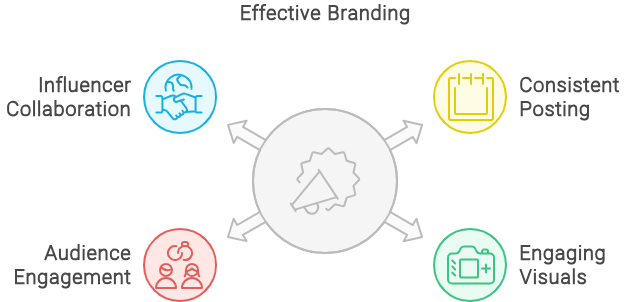As a Registered Massage Therapist (RMT) with over 7 years of experience and a passion for social media marketing, I’ve seen firsthand the power of strategic social media management in growing a successful practice. In this comprehensive guide, I’ll share my expertise on understanding social media basics, choosing the right platforms, building a strong online presence, creating engaging content, and measuring your success to help you attract more clients and stand out in a competitive market.
Understanding Social Media Basics

Social media can be a powerful tool for RMTs looking to connect with potential clients, build brand awareness, and grow their practice. According to a study by the Pew Research Center, 72% of adults in the United States use at least one social media platform.
To effectively leverage social media for your massage therapy business, it’s essential to:
- Identify your target audience and their preferred social media platforms
- Set clear, measurable goals for your social media marketing efforts
- Develop a consistent brand voice and visual identity across all platforms
- Create and share valuable, engaging content that resonates with your audience
- Engage with your followers and build genuine relationships
By mastering these fundamentals, you can establish a strong foundation for your social media presence and attract more qualified leads to your practice.
Choosing the Right Platforms
With numerous social media platforms available, selecting the ones that align with your target audience, business goals, and content strategy is crucial. Some key factors to consider when choosing platforms include:
- Demographics: Different platforms attract different age groups, genders, and interests. For example, Instagram tends to have a younger user base, while Facebook appeals to a broader age range.
- Content format: Certain platforms are better suited for specific types of content. YouTube is ideal for video content, while Instagram is known for its visual focus.
- Engagement: Consider the level of engagement and interaction each platform offers. Twitter is known for real-time conversations, while LinkedIn is geared toward professional networking.
As an RMT, some of the most relevant platforms to consider include:
- Facebook: Great for building community, sharing informative content, and running targeted ads
- Instagram: Ideal for showcasing your practice, sharing behind-the-scenes content, and attracting a younger audience
- LinkedIn: Useful for connecting with other healthcare professionals, sharing industry insights, and establishing your expertise
By focusing your efforts on the platforms that best align with your goals and audience, you can maximize your impact and avoid spreading yourself too thin.
Building an Online Presence

Once you’ve selected your platforms, it’s time to build a compelling online presence that attracts and engages your target audience. Some key strategies to consider include:
- Optimizing your profiles: Ensure your profiles are complete, professional, and accurately reflect your brand. Use high-quality profile and cover photos, write compelling bios, and include relevant keywords.
- Posting consistently: Develop a content calendar and commit to posting regularly to keep your audience engaged and improve your visibility. Aim for a mix of informative, entertaining, and promotional content.
- Leveraging visuals: Use eye-catching images, infographics, and videos to grab attention and make your content more shareable. According to a study by HubSpot, visual content is 40 times more likely to be shared on social media than other types of content.
- Engaging with your audience: Respond to comments, answer questions, and participate in relevant conversations to build relationships and establish trust with your followers.
- Collaborating with influencers: Partner with respected professionals in your industry to expand your reach, gain credibility, and attract new followers.
By consistently implementing these strategies and monitoring your analytics, you can continually refine your approach and build a strong, engaged online community.

Creating Engaging Content for Maximum Impact
The key to a successful social media presence is creating content that resonates with your target audience and compels them to take action. Some proven content strategies for RMTs include:
- Educational content: Share tips, techniques, and insights related to massage therapy, wellness, and self-care to establish your expertise and provide value to your followers.
- Behind-the-scenes content: Give your audience a glimpse into your practice, your team, and your massage therapy techniques to build trust and connection.
- Client testimonials: Share success stories and positive reviews from satisfied clients to build social proof and attract new clients.
- Interactive content: Use polls, quizzes, and Q&A sessions to encourage engagement and gather valuable insights from your audience.
- Trending content: Stay up-to-date on the latest industry trends, news, and events, and share your unique perspective to position yourself as a thought leader.
When creating content, focus on providing value, telling authentic stories, and using a mix of formats to keep your audience engaged and coming back for more.
Measuring Social Media Success

To ensure that your social media efforts are paying off and driving meaningful results for your massage therapy practice, tracking and analysing your performance regularly is crucial. Some key metrics to monitor include:
- Reach: The number of people who see your content
- Engagement: The likes, comments, shares, and clicks your posts receive
- Follower growth: The rate at which you’re gaining new followers over time
- Website traffic: The amount of traffic your social media profiles drive to your website
- Conversion rate: The percentage of social media visitors who take a desired action, such as booking an appointment or signing up for your newsletter
Tools like Facebook Insights, Instagram Insights, and Google Analytics can help you track these metrics and gain valuable insights into your audience and content performance.
By consistently monitoring your social media analytics and making data-driven optimizations to your strategy, you can continually improve your results and achieve your business goals.
Social media mastery is an ongoing journey that requires dedication, creativity, and a willingness to adapt to the ever-changing digital landscape. By understanding the fundamentals, choosing the right platforms, building a solid presence, creating engaging content, and measuring your success, you can effectively leverage social media to grow your massage therapy practice and stand out in a competitive market.
Frequently Asked Questions
What Are the 5 C’s of a Superior Social Media Strategy?
Are you looking for the secret ingredients to a successful social media game plan? Well, you’re in the right place. Let’s talk about the five C’s. These pillars are Content, Consistency, Community, Creativity, and Conversion.
Imagine them as the five gears in your car, all crucial to keep your social media machine running smoothly. High-quality and engaging content is your fuel—it’s what keeps your audience coming back for more. Now, Consistency is like your car’s regular maintenance—it keeps your brand’s image reliable and memorable.
When we talk about Community, think about it as your GPS. Engaging with your followers, responding to their comments, and making them feel part of your journey builds a strong and loyal community who will stick with you, no matter where you’re headed.
Creativity is, of course, your personal touch. It’s your car’s custom paint job or those flashy rims—it’s what sets you apart from all the other cars (or in this case, brands) on the road.
Finally, Conversion is your destination. It’s where all your hard work pays off, transforming your followers into customers.
What Is Social Media Mastery?
Social media mastery is all about knowing your way around platforms like Facebook, Instagram, and Twitter like the back of your hand. This involves creating exciting posts that grab people’s attention, using data to figure out what works and what doesn’t, and keeping up with the constant changes in how these platforms decide what to show to whom.
How Long Does It Take to Master Social Media Management?
Becoming proficient in managing social media is a long-haul endeavour, not something you rush through. You’re looking at around six months to a year of commitment, constant learning, and staying on top of the whims of social media trends.
How Do You Master Social Media Management?
Getting a handle on social media management isn’t a walk in the park – it’s a continuous learning process. I stay on top of the game by keeping my finger on the pulse of ever-changing algorithms, the latest trends, and shifting demographics. But it’s not just about understanding the theory – it’s about putting it into practice. To do this, I focus on crafting content that will resonate with my audience, and I’m not shy about using paid ads to boost my reach. Building a sense of community among followers is also high on my priority list. And to ensure I’m not just spinning my wheels, I regularly review and tweak my strategies based on what’s working and what’s not. That’s my secret sauce to mastering social media management.



